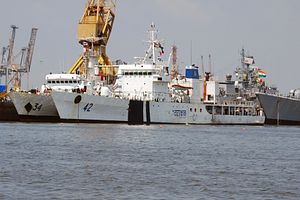David Headley, Lashkar-e-Taiba’s American-born “scout” ahead of the devastating November 2008 terror attacks in Mumbai that claimed over 170 lives, testified before an Indian court on Monday via a video conference. Headley’s remarks before the court have received wide coverage in the international media and contained few surprising or new details.
Headley’s testimony included references to the involvement of Pakistan’s Inter-Services Intelligence Directorate (ISI) in helping the Lashkar-e-Taiba terrorists infiltrate India to perpetrate the worst terror attack on Indian soil since the 2006 Mumbai train bombings.
In the investigation into the terror attacks, one of the major revelations was that the 10 terrorists had entered India not by land, but using inflatable speed boats by sea. The first Indians the attackers confronted weren’t Coast Guard or Navy, but gormless fisherman, perplexed by a group of 10 strange Urdu-speaking men who’d just arrived by sea. For the Indian Coast Guard, the events of November 2008 sparked an increased focus on coastal monitoring. The November 2008 attacks had shown that the sea remained a viable vector for terrorist entry into India.
Over the past year, attacks at Gurdaspur and Pathankot, in Punjab, have refocused attention on terrorists crossing the land border with Pakistan, but Headley’s testimony should be a reminder of the sea-based threat from Pakistan-based terror groups. Speaking to the court, Headley emphasized that the November 26, 2008 coastal arrival wasn’t the first attempt by the 10 attackers. In September 2008, Lashkar-e-Taiba operatives had made a failed attempt.
“The boat disintegrated. The men had life jackets on and came to shore. The weapons and explosives were lost in the ocean,” Headley said. While he wasn’t clear on the details of the second attempt, he said that it was made “a month or so later.” “I don’t know exactly where the boat started from, but probably outside Karachi,” he added.
The Indian Coast Guard is currently undergoing a fleet expansion, aiming to field an fleet of 150 ships and 100 twin-engine aircraft by 2020. At the time of the Mumbai attack, the Coast Guard fielded 65 ships. The Coast Guard crossed the 100 ship mark in 2014. In 2014, Indian Coast Guard Director General Anurag G. Thapliyal told reporters that “[the Mumbai attacks] brought in lot of self-awareness. Our coastline was generally considered to be secured. We never anticipated this kind of terror using the sea route. This also brought in awakening.”
Beyond the simple expansion of the fleet, the Indian Coast Guard has undertaken a range of practices since the Mumbai attack to make the detection and prevention of infiltration more feasible. For example, ordinary fishing boats are tagged and color-coded based on their place of origin. Identity cards have become mandatory for fisherman.
Finally, commercial vessels, including fishing boats, have been required to operate transponders (though full compliance is easier said than done). Organizationally, the Indian Coast Guard hasn’t been restructured to contain something like the United States Coast Guard’s Maritime Safety and Security Team, a counter-terrorism team put together after the September 11, 2001 attacks against New York City and Washington DC.
What’s worrisome is that even after the trauma of 2008, the Indian Coast Guard remains under-prepared to stave off a similar attempt at coastal infiltration. Some readers may recall an incident at the end of 2014, where the Coast Guard intercepted a Pakistani fishing boat thought to be carrying terrorists. The boat supposedly blew itself up, killing all four individuals on board. (Though off-the-cuff remarks by a senior Indian Coast Guard official suggest the boat may have been destroyed by Indian authorities.)
Headley’s testimony before the Indian court happened to come shortly after Indian Prime Minister Narendra Modi spoke at India’s International Fleet Review, emphasizing the “threat of sea borne terror.” India thus recognizes the importance of securing the maritime vector for possible terrorist infiltration, but should bolster its Coast Guard to adequately perform the task. Headley’s testimony is an all-too-timely reminder of the sea-based terror threat.

































